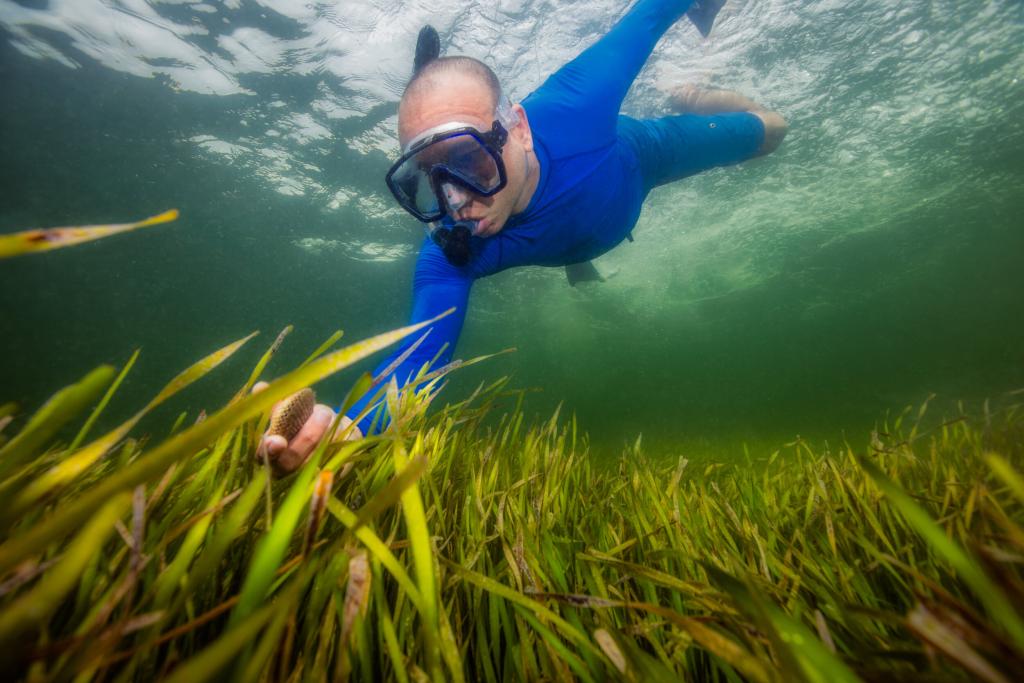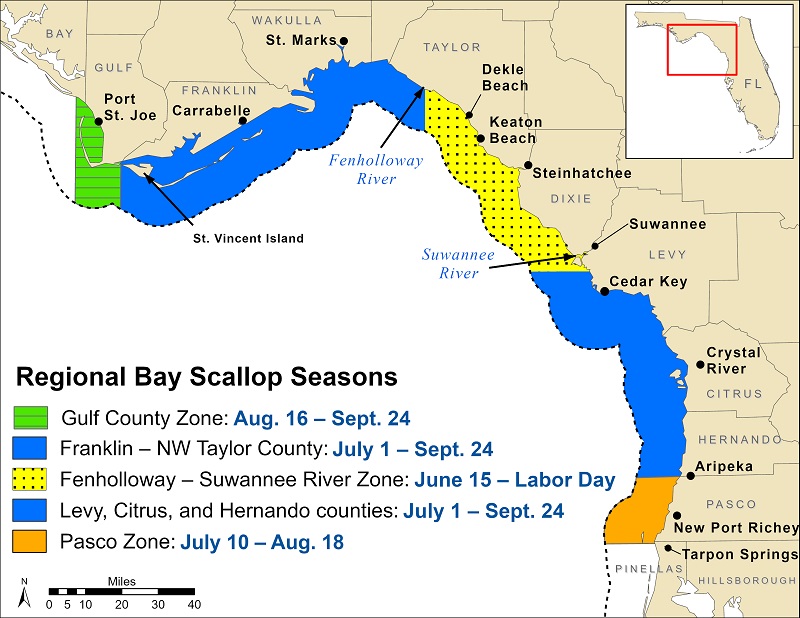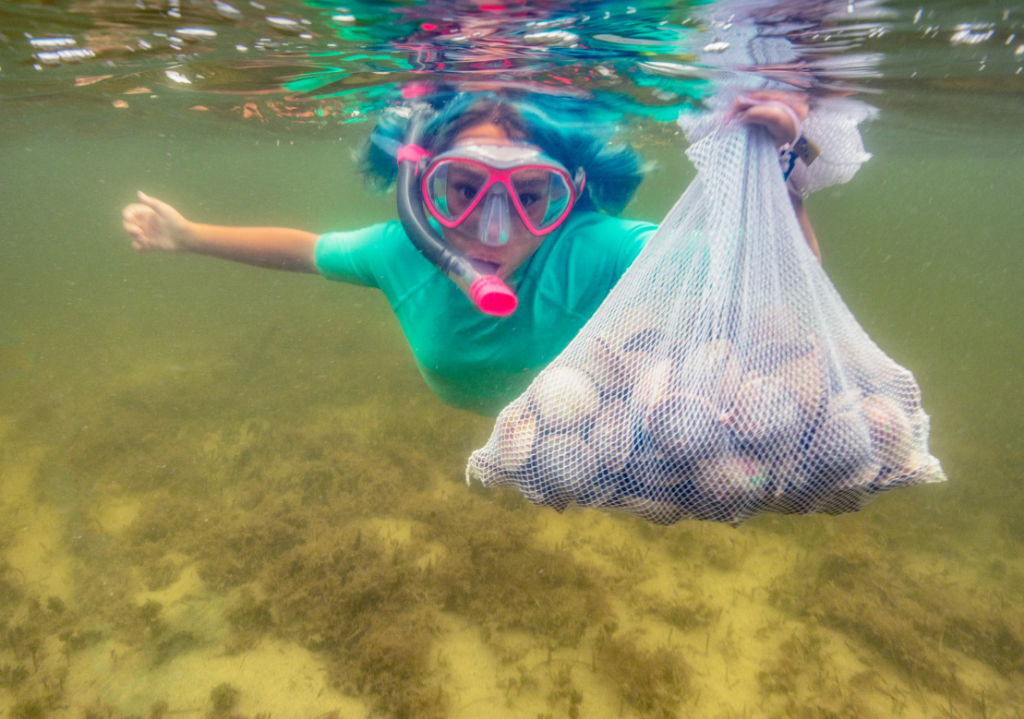Estimated reading time: 6 minutes

Scallops are harvested in various areas along the coast of the United States. However, if you’re interested in scalloping or harvesting for scallops, your go-to destination is Florida. But before you start planning, here are a few essential things to know before you go.
What’s the Difference Between Sea Scallops and Bay Scallops
:max_bytes(150000):strip_icc()/bay-scallops-sea-scallops-2000-77a8382980664a89bac46e8d641a636d.jpg)
Before you begin your scalloping adventure, it’s important to understand the difference between sea scallops and bay scallops. Most people are familiar with sea scallops, which are larger in size, normally ranging between 1.5 to 2 inches in diameter, and are harvested deep in the ocean. Bay scallops, however, are smaller, averaging only about a half-inch in diameter, and are harvested in shallow coastal waters. As for taste, bay scallops are tenderer and yield a sweeter flavor.
Now that you know the fundamental differences between the two, you’re probably thinking, “What does it have to do with my Florida scalloping trip?” Recreational scalloping in Florida is only for harvesting bay scallops. So get ready to feast on some freshly harvested, sweet, and tender seafood nuggets!
Florida Scallop Harvesting Season: Dates and Locations

When planning a scalloping trip to Florida, it is essential to know that not all coastal areas in the state are open to harvesting scallops. Furthermore, scalloping is only available on Florida’s western coast, starting from part of Bay County and moving south through Pasco County. Bay scallop seasons are broken down into the following areas and locations:
St. Joseph Bay/Gulf County: August 16-September 24
This area covers state waters from the Mexico Beach Canal in Bay County, extending to the farthest point of St. Vincent Island in Franklin County.
Franklin County Through Northwestern Taylor County: July 1-September 24
This area encompasses all the waters from the farthest west point of St. Vincent Island in Franklin County to Rock Island, close to the mouth of the Fenholloway River in Taylor County. Includes Carrabelle, Lanark, and St. Marks.
Fenholloway Through Suwannee Rivers Zone: June 15-Labor Day
This area covers all state waters located to the east of Rock Island by the entrance of the Fenholloway River in Taylor County and to the north of Alligator Pass near the mouth of the Suwannee River in Levy County. Includes Keaton Beach and the Steinhatchee area.
Levy, Citrus, and Hernando County Areas: July 1-September 24
This area comprises the state waters situated below Alligator Pass near the entrance of the Suwannee River in Levy County and above the Hernando – Pasco county line.
Pasco County: July 10-August 18
This area encompasses all state waters situated south of the Hernando – Pasco County line and north of Anclote Key Lighthouse in northern Pinellas County, covering all waters of the Anclote River.
Scalloping Gear and Must-Haves

When it comes to harvesting scallops, simply throwing on your best swimsuit and a slather of sunscreen just won’t cut it. With gear, think along the lines of snorkeling since you’ll be mainly grazing shallow waters for extended periods of time. You’ll need a mask and snorkel to help you stay longer underwater, fins/flippers to help you move faster, a netted bag to put your scallops in, and some reef-safe sunscreen. Finally, and most importantly, a saltwater fishing license. This is a requirement for all types of fishing, including crabbing and scalloping. The good news is they’re inexpensive, and you can purchase them ahead of time.
Scallop Harvesting Daily Bag Limits

Once you’ve started harvesting, don’t think that you can haul as much goods as your boat can carry. To protect from overharvesting, daily bag limitations are put in place. Different harvesting zones have different daily bag limit requirements:
Gulf area through Taylor County and Levy through Pasco County:
Per person: 2 gallons of whole bay scallops (in shell) or 1 pint of bay scallop meat
Per vessel: 10 gallons of whole bay scallops (in shell) or 1/2 gallon of bay scallop meat (4 pints)
Fenholloway area through Suwannee River Zone:
From July 15-30:
Per person: 1 gallon of whole bay scallops (in shell) or 1 cup of bay scallop meat
Per vessel: 5 gallons of whole bay scallops (in shell) or 2 pints of bay scallop meat
From July 1-Labor Day:
Per person: 2 gallons of whole bay scallops (in shell) or 1 pint of bay scallop meat
Per vessel: 10 gallons of whole bay scallops (in shell) or 1/2 gallon of bay scallop meat (4 pints)
Scalloping Best Practices

While you’re out there hunting scallops, be sure to follow these best practices and guidelines to help protect the bay scallop habitat and ensure its longevity for future generations to enjoy.
Do not harvest small scallops. Small scallops are young and must reproduce in the fall and winter months to ensure a plentiful harvest in the following seasons. If you find some smaller than 2 inches, throw them back in the water to protect the fishery. Plus, their smaller muscle mass might not be worth the effort.
Only keep what you will eat. One pint of scallop meat is approximately four servings, so rather than setting a goal of reaching the daily bag limit, set it based on how much you’re actually going to consume. Remember, scallop meat is only good for one day in the fridge and can be kept frozen for up to 3 months.
Don’t double dip. Local law enforcement officers will report scallopers that go out for a second trip after the first. Double dipping is unethical and illegal.
Protect the seagrasses. Many marine species, including scallops, call them home. Damage from boat propellers and anchors can be detrimental to seagrasses and the overall coastal habitat of the bay’s marine life.
Properly dispose of shells. Once you’ve shucked your bay scallops, shells should be disposed of in the open waters with moderate to strong currents. Disposing of shells in inshore waters such as channels, canals, and marinas can create hazards for swimmers and vessels.
Now that you’re fully equipped with useful scalloping information, it’s time to book your trip. And once you’ve gotten your fill of scallop harvests, be sure to check out our delicious scallop recipes!
For more articles on beach living, check out Beach Homes Lifestyles.

